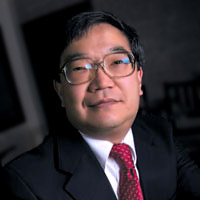James Fujimoto, Ph.D.

Research Laboratory of Electronics
Massachusetts Institute of Technology, USA
In work that could improve the diagnoses of many eye diseases, MIT researchers under the leadership of James Fujimoto have developed a new type of laser for taking high-resolution, 3-D images of the retina, the part of the eye that converts light to electrical signals that travel to the brain. The new imaging system is based on Optical Coherence Tomography (OCT), which uses light to obtain high-resolution, cross-sectional images of the eye to visualize subtle changes that occur in retinal disease. Conventional OCT imaging typically yields a series of two-dimensional cross-sectional images of the retina, which can be combined to form a 3-D image of its volume.
The system works by scanning light back and forth across the eye, measuring the echo time delay of reflected light along micrometer-scale lines that, row by row, build up high-resolution images. Commercial OCT systems scan the eye at rates ranging from several hundred to several thousand lines per second, but a typical patient can only keep the eye still for about one second, limiting the amount of three-dimensional data that can be acquired.
Now, using the new laser, researchers in Fujimoto's group report retinal scans at record speeds of up to 236,000 lines per second, a factor of 10 improvements over current OCT technology. Future clinical studies, as well as further development, may someday enable ophthalmologists to routinely obtain three-dimensional "OCT snapshots" of the eye, containing comprehensive volumetric information about the microstructure of the retina. Such snapshots could potentially improve diagnoses of retinal diseases such as diabetic retinopathy, glaucoma and age-related macular degeneration.
James Fujimoto is a principal investigator in the Research Laboratory of Electronics (RLE) at the Massachusetts Institute of Technology (MIT). He received his S.B., S.M., and Ph.D. in electrical engineering from MIT in 1979, 1981, and 1984 respectively. He joined the MIT faculty in 1985 as Assistant Professor of Electrical Engineering. Since 1994, he has been Professor of Electrical Engineering at MIT and Adjunct Professor of Ophthalmology at Tufts University. His area of research involves the development and application of femtosecond laser technology, studies of ultrafast phenomena, and laser medicine and surgery. His research group in RLE and collaborators invented optical coherence tomography and pioneered its development. Dr. Fujimoto was awarded the Discover Magazine Award for Technological Innovation in medical diagnostics in 1999, and was co-recipient of the Rank Prize in Optoelectronics in 2002.
This profile was created using an article written by Elizabeth A. Thomson, MIT News Office, April 30, 2007.









